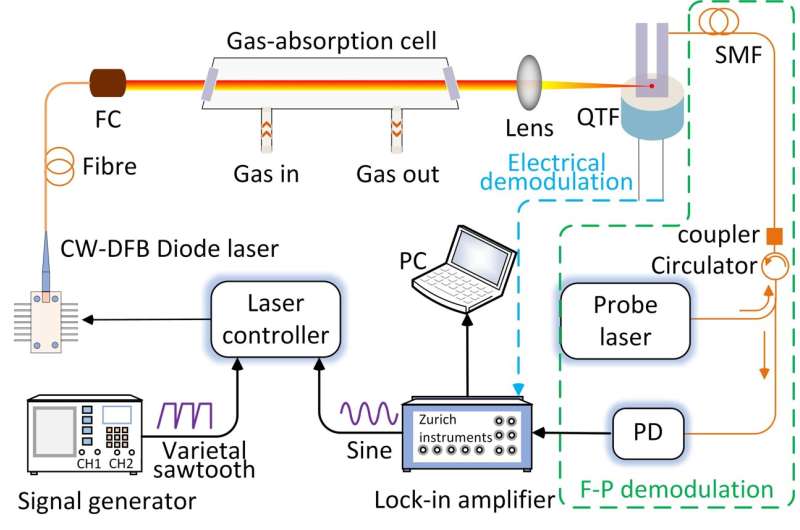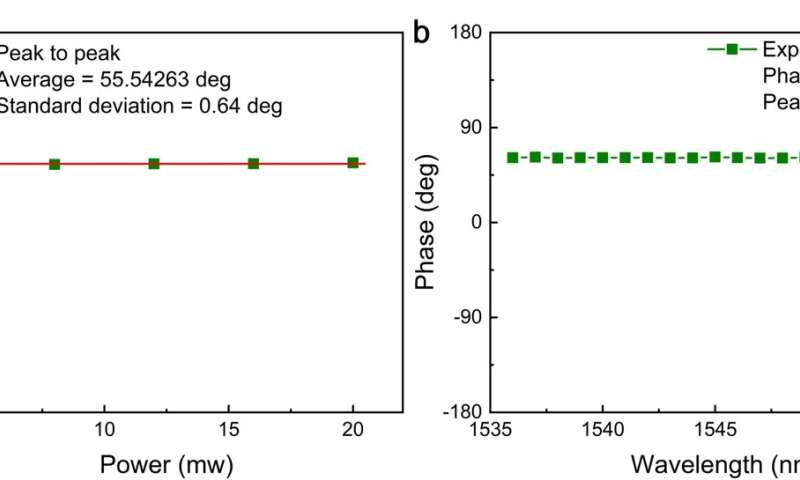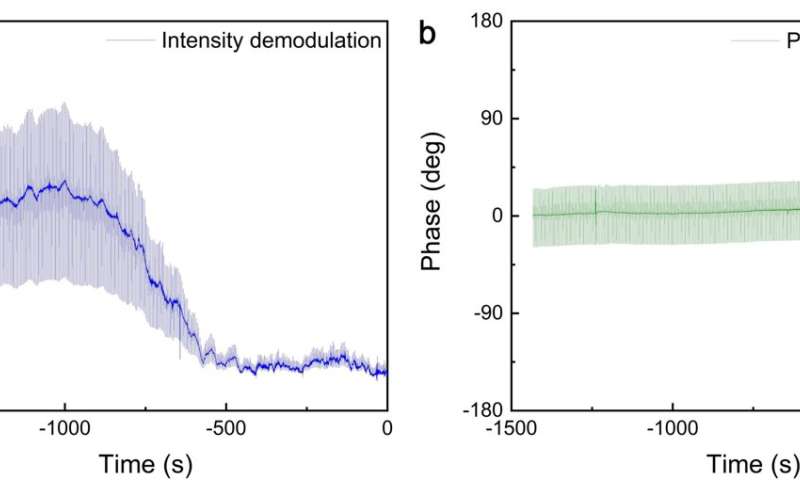This article has been reviewed according to Science X's editorial process and policies. Editors have highlighted the following attributes while ensuring the content's credibility:
fact-checked
proofread
Fabry–Perot-based phase demodulation of heterodyne light-induced thermoelastic spectroscopy

Trace gas sensors are used in different fields. Light-induced thermoelastic spectroscopy (LITES) has extremely high sensitivity and offers non-contact measurement, attracting extensive research attention. In general, the electrical signal amplitude increases linearly with an increase in laser power.
However, thermal noise caused by laser irradiation in electrical signals magnifies exponentially as the laser power increases, restricting the signal-to-noise ratio (SNR) and minimum detection limit (MDL) of a LITES sensor.
A potential solution is demodulating the vibration of the QTF in place of the electrical signal. Fabry–Perot (F–P) interferometers (FPI) are safe, remote, sensitive, anti-electromagnetic interference measurement devices for micro-vibration. For F–P micro-vibration sensors, the intensity demodulation method is typically used. Owing to ambient interference and disturbance of the laser wavelength, the signal becomes unstable.
In a new paper published in Light: Advanced Manufacturing, a team of scientists, led by Professor Yufei Ma from National Key Laboratory of Science and Technology on Tunable Laser, Department of Aerospace, Harbin Institute of Technology, China, and co-workers have developed a F–P-based phase demodulation of heterodyne LITES (H-LITES).
-

a, Using the phase demodulation method, the peak-to-peak values of H-LITES signal were generally consistent, with an average of 55.54° and a standard deviation of 0.64°. The phase demodulation method is immune to disturbances from the laser source, and can produce excellent detection performance even with a low-power probe laser. b, The peak-to-peak values remained constant at wavelengths from 1536 nm to 1555 nm. The phase demodulation method is approximately wavelength-independent, with the same sensitivity at any wavelength; it does not require the wavelength to be fixed at the Q-point, and is immune to laser wavelength disturbances. Q-point drifting due to ambient interference can be overcome using the phase demodulation method in the FPI. Credit: Ziting Lang, Shunda Qiao, and Yufei Ma -

a, Using the intensity demodulation method, the peak-to-peak values of the H-LITES signals gradually decreased over time; the stability was poor. b, The peak-to-peak values of the H-LITES signals obtained using the phase demodulation method were consistent, demonstrating that FPI-based H-LITES with phase demodulation method had excellent system stability. Credit: Ziting Lang, Shunda Qiao, and Yufei Ma
The F–P cavity is comprised of an end-face of a single-mode fiber and a side of a prong of the QTF. When the QTF vibrates due to the effect of light-induced thermoelastic, the F–P cavity length varies; thus the phase changes. Because the vibration of the QTF is proportional to the gas concentration, the concentration can be inverted linearly by demodulating phase.
Compared to the H-LITES signal obtained directly from the electrical signal, the signal based on FPI had a greater SNR. The phase demodulation method can produce better detection performance, linear response, and long-term stability than the intensity demodulation method.
Using the phase demodulation method, the signal peak-to-peak values are independent from power and wavelength. The phase demodulation method is immune to interference from the laser source and wavelength, and can resolve the issue of Q-point drifting due to ambient interference.
More information: Ziting Lang et al, Fabry–Perot-based phase demodulation of heterodyne light-induced thermoelastic spectroscopy, Light: Advanced Manufacturing (2023). DOI: 10.37188/lam.2023.023
Provided by Light Publishing Center, Changchun Institute of Optics, Fine Mechanics And Physics, CAS





















